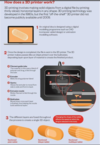Lecture 15- 3d printing of medicine Flashcards
1
Q
Conventional manufacturing vs 3D Printing?
A
- Conventional manufacturing -subtractive manufacturing:
- A large block of material is cut down to its required shape –size-reduction
- Leads to lots of waste
- 3D Printing:
- A product is made by fusing or depositing materials to produce a 3-dimensional product
- Minimal waste materials produced
- Materials vary from plastic, metals ceramics, powders, liquids etc. to even living cells
- a.k.an Additive Manufacturing (AM)
- Rapid Prototyping (RP)
- Solid Free-form Technology (SFF)
2
Q
Overcoming the challenge of traditional tablet manufacturing
A
- Pharmaceutical ink= everything you need to make your product
- Reduced number of step

3
Q
Applications of 3D printing
A
- Extensive use in Aerospace, Architecture, Automobiles, Education, Jewellery, Manufacturing, Rapid prototyping, Textiles etc
- More importantly, used in Medicine
- Netherlands –3D printed jaw replacement
- Bangalore –3D printed body parts to pre-plan surgeries and reduce operation time
- Fashion Designers have started printing clothes using 3D printers
- US –FDA approved first 3D printed drug, Spritam® in 2014
4
Q
Current trends in 3D printing
A

5
Q
Advantages of 3D Printing
A
- Low scale production- less waste of material
- Production customisation- no limitation of what excipient we can use
- No need for logistics- make it yourself
- If you can think it, you can make it
6
Q
Benefits
A
- Increased product complexity
- Integrated with a healthcare network
- Mini-dispenser unit
- Personalised medicine
- On-demand manufacturing
7
Q
Why bother

A

8
Q
Benefit
Efficacy/Acceptability
A
- Criterion for drug product
- Dosage; Preparation administration; compliance
- Product requirements
- Dose flexibility
- Acceptability of size/volume
- Easy and convenient handling
- Easy administration
- Acceptable appearance and taste
- Minimal administration frequency
9
Q
Benefits
Patient safety
A
- Criterion for drug product
- Bioavailability excipients
- Stability
- Medication error manufacturability
*

10
Q
What is needed
A
- 3d digital version of the object (Stereolithography) defined in a Computer-Aided Design (CAD) file
- Format file lists the co-ordinates of triangles that together make up the surface of the designed 3D structure
- CAD file defines the geometry and size of the object
- 3D printer
- 3D printer filament
- Basically, the 3D printer follows the instructions in the CAD file to build the foundation of the object, printing along the x-y plane
- After which it follows the instructions, moving the print head along the z-axis to build the object vertically, layer by layer
11
Q
How does a 3D printer work
A

12
Q
3D printing technologies
A
- Priting-based inkjet system
- Nozzle-based deposition systems- melting the polymer and building layer
- Laser-based writing system- photosensitive polymer- UV light changes the shape of the polymer

13
Q
3D printing technologies
A
- FFF –Fused Filament Fabrication
- Most widely used
- The filament is heated and then extruded through a nozzle
- Deposits material layer by layer
- Steps:
- The 3D design is sliced in layers
- Sliced design is converted to G Codes using software
- G Code is fed into the 3D printer and commands extruder’s movement and thus material deposition
- FFF Printing
14
Q
Current limitations of 3D printing
A
- Limited range of materials can be produced by it
- No thermosensitive
- No UV sensitive material
- Toxicities of these new materials
- High cost -large scale manufacturing still cheaper
- Time constraints –it takes several hours to complete a single product, compared to conventional multi-station tabletting machines
- Speed
*

15
Q
Future perspectives
A
- 3D printed medicaments for personalised medicines
- Patients may be able to download compositions and digital signatures to print drugs at home
16
Q
A
17
Q
BENEFITS OF 3D PRINTING
EPP
A
- EFFICACY/ACCEPTABILITY-
- PATIENT SAFETY-
- PATIENT ACCESS-

18
Q
Potential benefits for geriatric population
A

19
Q
A


